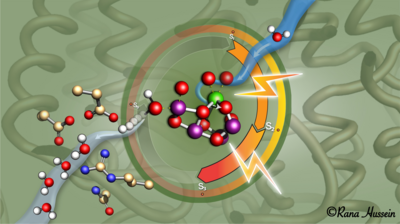Structural dynamics in the water and proton channels of photosystem II during the S2 to S3 transition
Rana Hussein, Mohamed Ibrahim, Asmit Bhowmick, Philipp S. Simon, Ruchira Chatterjee, Louise Lassalle, Margaret Doyle, Isabel Bogacz, In-Sik Kim, Mun Hon Cheah, Sheraz Gul, Casper de Lichtenberg, Petko Chernev, Cindy C. Pham, Iris D. Young, Sergio Carbajo, Franklin D. Fuller, Roberto Alonso-Mori, Alex Batyuk, Kyle D. Sutherlin, Aaron S. Brewster, Robert Bolotovsky, Derek Mendez, James M. Holton, Nigel W. Moriarty, Paul D. Adams, Uwe Bergmann, Nicholas K. Sauter, Holger Dobbek , Johannes Messinger, Athina Zouni, Jan Kern, Vittal K. Yachandra and Junko Yano
Learning from nature is one of the great challenges the Cluster of Excellence UniSysCat faces. With the aim to develop catalysts that are as powerful as natural enzymes - or even more efficient - biochemists working in UniSysCat are investigating very carefully how certain natural catalysts work. A particularly fascinating catalytic process in nature is photosynthesis: Using sunlight, certain molecules called photosystems are able to convert CO2 from the atmosphere to energy-rich biomolecules. In times of climate change, researchers strive to understand photosynthesis in very much detail hoping to be able to use the process for the production of clean energy. However, the fundamental mechanism that produces energy from light, water and CO2 in plants has not yet been fully deciphered.
An international research team featuring the UniSysCat groups of Prof. Athina Zouni and Prof. Holger Dobbek from Humboldt Universität Berlin as well as Prof. Junko Yano from Berkeley Lab, who is a member of the Scientific Advisory board of UniSysCat, and their partners from Uppsala University in Sweden now made a big step towards understanding photosynthesis in more detail: they provide important new findings on the working principle of photosystem II (PS II), one of the key catalytic systems in natural photosynthesis.
PS II stands for the first step in photosynthesis: it is the catalytic system at which the light-driven reation of water splitting takes place. In this reaction, protons and O2 are produced. Using ultrashort X-ray laser pulses, the researchers now generated atomic snapshots of the PS II and to observe the functioning of the biological nanosystem during the water-splitting reaction.
At the SLAC National Accelerator Laboratory, the researchers collected atomic snapshots of the PS II as it went through its catalytic cycle - somewhat like a "molecular movie" of the water-splitting reaction was generated. Thus, they could identify the channel for the uptake of water molecules to the catalytic center, an Mn4CaO5 cluster, and reveal the processes taking place there. The snaphshots were taken during the crucial S2 –> S3 transition, whereby a substrate water binds to the active site on the Mn4CaO5 cluster. Hence, the study has provided a great visualization of the potential pathways for water insertion and proton release. It is a first step showing how the coordinated motion of amino acid residues at PS II and the water network is key to control the transport of water and protons which is required for a complex process like the water-splitting reaction.
“We hope that we can develop artificial catalysts in the near future. The key to this is the elucidation of the molecular mechanism of the water-splitting reaction, whereby we are particularly interested in the function of common metals such as Mn in an inorganic cluster in PSII in water oxidation," says Rana Hussein from Prof. Athina Zouni's group - the first author of the publication.
The findings of Hussein et al. have been published in Nature Communications: Hussein, R., Ibrahim, M., Bhowmick, A. et al. Structural dynamics in the water and proton channels of photosystem II during the S2 to S3 transition. Nat. Commun. 2021, 12, 6531. https://doi.org/10.1038/s41467-021-26781-z


